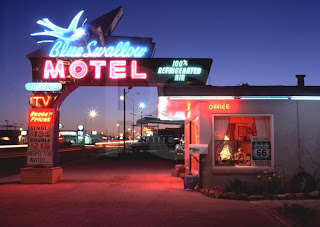
Motels developed in the second decade of the twentieth century to fill the need for functional, accessible, and economical sleeping accommodations catering to the burgeoning number of automobile travelers. Variously known as "tourist cabins," "motor courts," or "cabin camps," individually operated cabin complexes sprang up along highways, especially in the South and West.
The term "motel," a contraction of "motor" and "hotel," was coined in the mid-1920s. By the mid-1930s motels were more decorative, with quaint exteriors mimicking local architectural motifs. A few entrepreneurs experimented with luxurious or exotic designs, including accommodations adapted from aircraft or modeled on log cabins, historic structures, even wigwams.
The number of motels exploded following World War II (1939–1945), tripling from about 20,000 in 1940 to over 60,000 by 1960. More economical and standardized attached units, individualized by absurdly garish signs, gradually replaced cabins as the preferred motel design.
In the second half of the twentieth century, the individually owned motel gave way to corporate chains such as Best Western and Holiday Inn. Motels are increasingly similar to the hotels that they once challenged, locating in urban areas, adding stories, and, especially, creating elegant spaces and business centers to accommodate private and corporate events.


0 comments:
Post a Comment